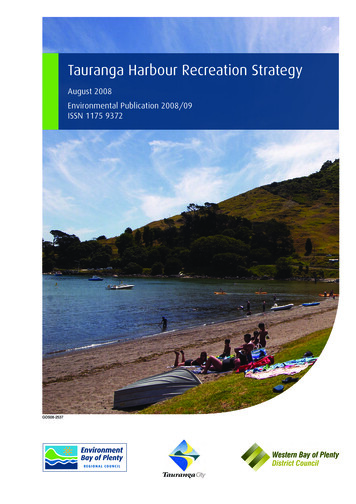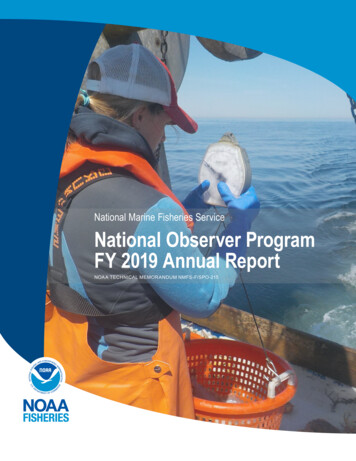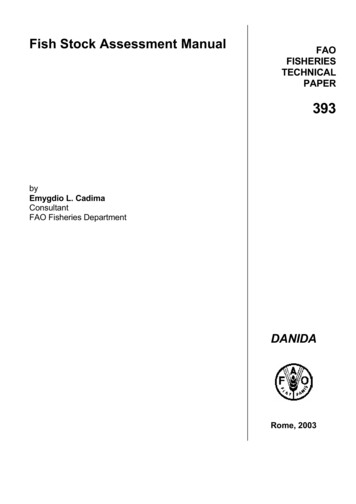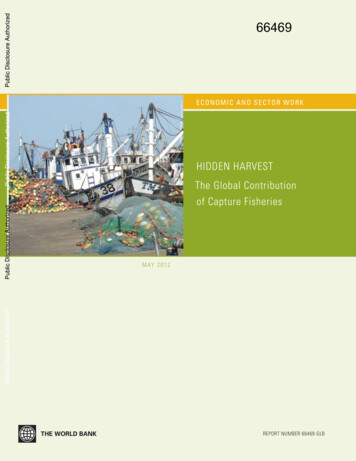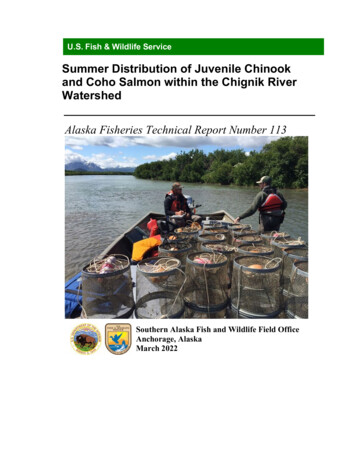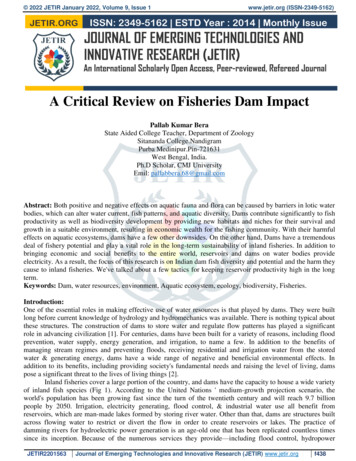
Transcription
2022 JETIR January 2022, Volume 9, Issue 1www.jetir.org (ISSN-2349-5162)A Critical Review on Fisheries Dam ImpactPallab Kumar BeraState Aided College Teacher, Department of ZoologySitananda College.NandigramPurba Medinipur.Pin-721631West Bengal, India.Ph.D Scholar, CMJ UniversityEmil: pallabbera.68@gmail.comAbstract: Both positive and negative effects on aquatic fauna and flora can be caused by barriers in lotic waterbodies, which can alter water current, fish patterns, and aquatic diversity. Dams contribute significantly to fishproductivity as well as biodiversity development by providing new habitats and niches for their survival andgrowth in a suitable environment, resulting in economic wealth for the fishing community. With their harmfuleffects on aquatic ecosystems, dams have a few other downsides. On the other hand, Dams have a tremendousdeal of fishery potential and play a vital role in the long-term sustainability of inland fisheries. In addition tobringing economic and social benefits to the entire world, reservoirs and dams on water bodies provideelectricity. As a result, the focus of this research is on Indian dam fish diversity and potential and the harm theycause to inland fisheries. We've talked about a few tactics for keeping reservoir productivity high in the longterm.Keywords: Dam, water resources, environment, Aquatic ecosystem, ecology, biodiversity, Fisheries.Introduction:One of the essential roles in making effective use of water resources is that played by dams. They were builtlong before current knowledge of hydrology and hydromechanics was available. There is nothing typical aboutthese structures. The construction of dams to store water and regulate flow patterns has played a significantrole in advancing civilization [1]. For centuries, dams have been built for a variety of reasons, including floodprevention, water supply, energy generation, and irrigation, to name a few. In addition to the benefits ofmanaging stream regimes and preventing floods, receiving residential and irrigation water from the storedwater & generating energy, dams have a wide range of negative and beneficial environmental effects. Inaddition to its benefits, including providing society's fundamental needs and raising the level of living, damspose a significant threat to the lives of living things [2].Inland fisheries cover a large portion of the country, and dams have the capacity to house a wide varietyof inland fish species (Fig 1). According to the United Nations ' medium-growth projection scenario, theworld's population has been growing fast since the turn of the twentieth century and will reach 9.7 billionpeople by 2050. Irrigation, electricity generating, flood control, & industrial water use all benefit fromreservoirs, which are man-made lakes formed by storing river water. Other than that, dams are structures builtacross flowing water to restrict or divert the flow in order to create reservoirs or lakes. The practice ofdamming rivers for hydroelectric power generation is an age-old one that has been replicated countless timessince its inception. Because of the numerous services they provide—including flood control, hydropowerJETIR2201563Journal of Emerging Technologies and Innovative Research (JETIR) www.jetir.orgf438
2022 JETIR January 2022, Volume 9, Issue 1www.jetir.org (ISSN-2349-5162)generation, water supply for personal and industrial use, water storage, navigation, fish farming, andrecreation—dams have become a necessary component of the nation's basic infrastructure [3]. Another majortechnical measure in dealing with the water-human interaction is dam development. The Indian economycorrectly referred to these dams as the 'Modern Temples of India'. Tourism and recreation provide significantsocial and economic benefits and cultural and aesthetic value to visitors from all over the world. More than45,000 dams with an elevation of more than 15 meters have been built around the world, and around 73% ofthem were completed in the last 50 years. 2900 BC saw the construction of the world's first known dam, whichwas built across the River Nile to protect the Egyptian city of Memphis from floods. In China, the YalongJiang Dam is the world's highest dam (305 meters), followed by Tehri Dam in India (261.1 meters) on theBhagirathi River in Uttarakhand. The Hirakud dam in Odisha, India, is the country's longest dam, measuring26 kilometers in length and erected across the Mahanadi River. Human-made reservoirs with a surface greaterthan 0.01 mha are thought to exist in 16.7 million locations around the world. Power generation and irrigationare the primary goals of the country's numerous dams, which have been erected all around the country.Currently, the country's total reservoir area is 3.15 million hectares, with small reservoirs occupying 1.49million hectares, followed by large reservoirs (1.14 million hectares) and medium reservoirs (1.0 millionhectares) (0.52 mha). In spite of decades of large-scale groundwater recharge initiatives running in India'swater-scarce areas, no meaningful emphasis has been placed on flood risk management. The principal land-tosea transportation routes for water, nutrients, organic matter, and particulate matter are rivers.River basin development, particularly dam construction, has an immediate and dramatic impact on oceanstream inputs. This is an important topic. Freshwater fish diversity is threatened by both hydroelectric dam andclimate change. A reduction in fossil fuel consumption by shifting energy generation to large dams may reduceglobal warming, but this will have the unintended consequence of radically altering riverine habitats. However,the global demand for energy and the ongoing search for clean, renewable power has been a topic of interest tocountries in both developed and developing countries around the globe.Even though dams have been controversial for decades because of their negative environmental andsocial effects, the limited as well as uneven distribution of water on a global scale, has made the world realisethat more dams, primarily large dams, are required to promote development and to meet basic human needs.Human involvement in the hydrological cycle is one of the most crucial, and to fulfill future angling demand,fishery biologists must use all available effective strategies to boost the production and capture of reservoirfishes (Fig 2).Figure 1: Examples of tropical river fish and habitats that have been impacted by dam constructionEssential of Dams:Dams are mostly used to store water, whereas barricades and other structures like them are employed to controlthe flow of water into a certain land region. Dams are built to regulate and control the natural flow of water forvarious purposes, including water supply and irrigation, flood control, hydropower, navigation, recreation, andpollution abatement. Dams are also built to protect fish and wildlife and reduce salinity and sediment andrecharge groundwater. As a result of increasing populations and increased economic activity, human demandfor water & related services will continue to rise. Changes in population, economics, and technology all havean effect on how much water is needed. Dams, particularly huge ones, are now a must for the world's economicand social progress to continue. Population increase is driving up the need for water, but other factors such asrising energy, food, biofuel prices, and climate change fears are also weighing in.JETIR2201563Journal of Emerging Technologies and Innovative Research (JETIR) www.jetir.orgf439
2022 JETIR January 2022, Volume 9, Issue 1www.jetir.org (ISSN-2349-5162)How dams affect aquatic ecosystems:Decomposing organisms initially boost the nutrient content of the water, but this effect wears off after a fewdays. BOD (Biological Oxygen Demand) water value increases as a result. An anaerobic breakdown media isperformed using stationary layers along the reservoir depth. As a result, the lake will have a terrible odour. Asa result of this, a massive increase in phytoplankton populations can be seen. Macroflora also grows on thewater's surface in addition to the huge green-dark coloured bodies that blanket the water's surface. The lake'slife, as well as the enjoyment of those who go fishing or boating, and even the dam gates & turbine propellers,can be jeopardised by these events. The macroflora that grows here can serve as a breeding ground forpathogens. The increased number of water plants also causes larger evaporation losses than would otherwise bethe case due to regular evapotranspiration. Getting from one end of the river to the other might be a challengefor the animals that use it. The dam puts an end to the lives of fish that spend some of their lives in thefloodwaters of the spring and others at the point where the river empties into the ocean. We know that certainmarine fishes migrate to freshwater & swim up to the springs in order to lay their eggs [4]. Later on, theyreturn to the ocean with a new batch of juvenile fish. The dam's construction will disrupt these creatures' lifecycles, resulting in a large number of deaths. By-pass flows have been shown to be specifically intended forthis function.Figure 2: Traditional fishery.Dam and reservoir effects on fish biodiversity:More than only affecting the flow of water, damming a river has a number of repercussions on the freshwaterecosystem. For example, in the tropics there were considerable losses in both richness and variety as a result ofdam construction; in temperate reservoirs, the changes were less pronounced but nonetheless similar; and inboreal reservoirs, there were no changes at all. Large and medium dams obstruct over half of the 397freshwater ecoregions studied, and an additional 27% are hampered by impediments further downstream [5].Since freshwater environments are under attack from a wide range of hazards, it is imperative that we fullycomprehend these dangers if we are to stop this crisis from worsening. Put another way, by building big damsthat are more than 15 metres high, large rivers are transformed into storage reservoirs, which alters the ecology[6]. Species that live in rivers have a variety of migratory routes. Catadromous fish, such as eels, are alsoincluded in the anadromous fish family. Anadromous species migrate up rivers to spawn, while catadromousspecies go the other way around. Other effects on fish (including aquatic mammals) included obstructingmigration routes, fragmenting habitats and releasing hypolimnetic cold water from the reservoir, as well asalterations to downstream water flow. The development of dams around the country has severely harmed ournative fish species. Deposition of silt as well as other suspended particles occurs as a result of the reservoirs'regular water level variations. There are many examples of dams causing the disappearance of mahseer in theBhagirathi River.Dams harm fish in the following ways:The reproductive, juvenile, development and sexual maturation stages of the life cycle of a migratory fish allnecessitate distinct habitats. Diadromous creatures spend some of their lives in freshwater and others insaltwater. For example, the Gulam Mahommed Dam on the Indus River has disadvantaged the migratoryHillsa Ilisha of 60% of their previous breeding areas and dam construction on the Columbia River and its mainJETIR2201563Journal of Emerging Technologies and Innovative Research (JETIR) www.jetir.orgf440
2022 JETIR January 2022, Volume 9, Issue 1www.jetir.org (ISSN-2349-5162)tributary, the Snake River, resulted in the flooding of most spawning habitat, creating an unnaturalenvironment for fish and aquatic species. Indirectly, the passage via spillways may enhance the vulnerability ofdisoriented fish or frightened to predation. For macroinvertebrates and fish, channel incisions caused by theoutflow from dams can impair ecosystems within channels [7]. This is the most immediate effect of sedimentdeprivation. The United Nations has issued a dire warning that more than five billion people might face watershortages around the world if India's dams are not reined down. A number of studies have shown that manmade impediments, including power station outputs, residual flow stretches, dams, weirs, and fishways, candelay the upstream migration for many weeks.Dams' physiochemical profile:If the spillway is closed, the water's oxygen level drops, whereas if it's open, it rises. This physiochemicalvariation is dependent on the dam's spillway condition. The structure and functioning of a hydroelectric damcan have an impact on the downstream river's water quality. Soil physicochemical factors affect a wide rangeof processes, including microbiological activity and aquatic breeding, whereas physicochemical waterparameters have an impact on domestic life. In addition, damming physically influences the reservoir's waterquality, which in turn affects downstream rivers and their related wetlands, causing ecological consequences.Damming influences the reservoir's chemistry, which in turn alters the water's physical and chemicalproperties, resulting in ecological consequences for nearby rivers and wetlands.Dams' impact on the economy and society:Most of the people who live near rivers in rural areas of India rely on dams to provide for their basic needs bycatching fish and engaging in other leisure fishing activities. A development tool over the past century, largedams have impacted millions of people's daily lives and the nations they've helped shape in terms of theenvironment, economy, and society. This isn't the only thing that makes dams a crucial part of waterconservation [8]. A growing global population means that the water needed to produce electricity andguarantee food security is becoming increasingly competitive. Overall, dam construction in China haspositively affected the country's socioeconomic development. One of the best alternatives available to satisfyfuture increases in freshwater, food, and energy demands, all of which are vital for maintaining economicdevelopment, is the construction of further major dams. Furthermore, dams have been a major component inadjusting the geographical and temporal variations in water accessibility, which, if adequately exploited, mightprovide human beings clean, efficient, reliable, and renewable energy. Dams, for example, have played acritical role in the economic and social development of the United States. Water loss can be minimised throughthe use of bunds and small dams. Sediment concerns are expected to be alleviated by short-chain buildingdams. People living in poverty can find work thanks to dams, and the economy in urban and rural areasbenefits. According to Book Divine Providence Dam has also played an important role, and it will continue todo so for generations to come. On the contrary, the large dams in Punjab and Haryana have been the drivingforce behind a chain reaction of economic activity that has led to overall prosperity [9].Dams' impact on human life:But even if dams are a key development aim, they are not easily acceptable for the people whose agriculturalregions, homes, and the environment in which they live are submerged. Despite the fact that an improvedhabitation space for 80 000 people was made available in another place when Ghana's Volta Lake wasestablished in 1969, the original 100 000 inhabitants have relocated and built their own homes on the lake'scoast without permission. A social-psychological failure might be extremely harmful to the biosystems in theregion and the reservoir itself. Expropriation of land, hiring of construction employees, and delivery ofconstruction materials on-site by machinery are all examples of changes that occurred before the dam wasbuilt. Technicians and experts are brought in from out of town, yet unqualified labour are hired on-site. Allsettlement areas and social buildings are often created for persons from outside the site. It becomes a sign ofprogress when more of these facilities are made available to the public. In this way, new settlements improveand give rise to new ecological demands and changes. This is a good thing. Drinking water, residentialwastewater, wastewater treatment, and so on are all examples of this. In addition, the social scene is energised,trade flourishes and cultural pursuits take off. The transportation network has seen significant transformations.In this regard, the paths that lie below the surface of the water and the surrounding region are crucial. The newJETIR2201563Journal of Emerging Technologies and Innovative Research (JETIR) www.jetir.orgf441
2022 JETIR January 2022, Volume 9, Issue 1www.jetir.org (ISSN-2349-5162)roads built to ensure that transportation services would not be disrupted have resulted in increased costs andenvironmental damage.As a result, dams reduce pollution in the downstream area by reducing the pollution load that originates therebecause of large reservoirs. In addition, they reduce the pollution burden by storing water in their beds duringdry months, which further reduces pollution. Dams lower the risk of flooding downstream by their storageopportunity in their reservoir. It is undeniable that these projects yield actual and potentially significantadvantages. The increased power output has accelerated industrial development, leading to improvements inirrigation systems and agricultural production. In the meantime, flood protection is provided by dams for thosewho live downstream. A dam decision might be made after weighing the advantages and disadvantages of theproject for an extended period of time. Dams may no longer be necessary for the future because of their longterm benefits. On the other hand, these massive technical feats should remind us that we cannot alter only aportion of the ecosystem because the ecosystem is made up of many interconnected chains. The entire systemcan be brought to a grinding halt if even a single link or cog tooth breaks away. As a result, the surroundingsshould be thoroughly scrutinised during the conceptualization phase. Big risks can be avoided by takingprecautions ahead of time to account for even the tiniest, most sensitive responses.It is critical to reduce the negative environmental effects of dams to achieve sustainable development and thesignificant benefits they provide in terms of social and environmental well-being.The environmental impact assessment concept takes into account the aforementioned consequences and theircorresponding remedies. For the sake of clarity, the effects of damsa on the ecosystem are not uniform inmagnitude or significance. Understanding the interrelationships between these impacts and foreseeing whichpositive and negative consequences will arise is difficult in advance. Each dam & reservoir should have itsown estimate. On either hand, it is erroneous to perceive the repercussions wholly adversely. The most crucialquestion is who will do the evaluations and from what perspective they will be done. Is it the fisherman, theindustrialists, or the farmer whose land is submerged? No matter who has made the decision or whom thechoice will take into the centre, as long as full environmental repercussions are described totally according toits importance level.Conclusion:However, as the coin mentioned above has two sides, the enormous modern barriers on many water bodieshave an extremely severe influence on the aquatic ecology. This is especially true for the aquatic ecosystem'secosystem. For example, one side of dams that have a positive impact is used to control flooding and irrigation& hydropower generation, while the other side of dams that have an antagonistic effect include the relocationof individuals, changes in suspended sediment flows as well as a disruption to natural environments as well aslivelihood.References:1. Altinbilek D. The role of dams in development. Water Science and Technology 2002;45(8):169-80.2. Kano Y, Dudgeon D, Nam S, Samejima H, Watanabe K, Grudpan C et al. Impacts of dams and globalwarming on fish biodiversity in the Indo-Burma hotspot. PloS one 2016;11(8):e0160151.3. Friedl G, Wüest A. Disrupting biogeochemical cyclesConsequences of damming. Aquatic Sciences2002;64(1):55-654. Jhingran AG. Reservoir fisheries in India. Journal of the Indian Fisheries Association 1988;18:261-73.5. Dwivedi VK, Gupta SK, Pandey SN. A study of environmental impact due to construction and operation ofdam. In National Conference on Eco friendly Manufacturing for Sustainable Development 2010, 31.6. Kondolf GM. PROFILE: Hungry water: Effects of dams and gravel mining on river channels.Environmental management 1997;21(4):533-51.7. Lehner B, Liermann CR, Revenga C, Vörösmarty C, Fekete B, Crouzet P et al. High‐ resolution mapping ofthe world's reservoirs and dams for sustainable river‐ flow management. Frontiers in Ecology and theEnvironment 2011;9(9):494-502.8. McCartney MP, Sullivan C, Acreman MC, McAllister DE. Ecosystem impacts of large dams. Backgroundpaper 2001, 2.9. Shi H, Chen J, Liu S, Sivakumar B. The role of large dams in promoting economic development under thepressure of population growth. Sustainability 2019;11(10):2965.JETIR2201563Journal of Emerging Technologies and Innovative Research (JETIR) www.jetir.orgf442
Ph.D Scholar, CMJ University Emil: pallabbera.68@gmail.com . was built across the River Nile to protect the Egyptian city of Memphis from floods. In China, the Yalong Jiang Dam is the world's highest dam (305 meters), followed by Tehri Dam in India (261.1 meters) on the . (0.52 mha). In spite of decades of large-scale groundwater recharge .

